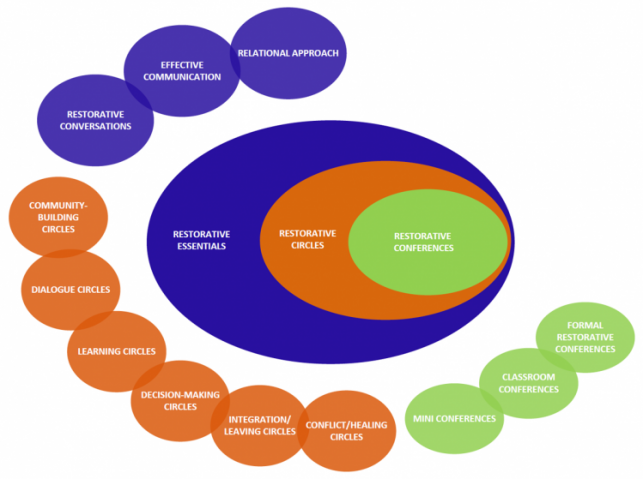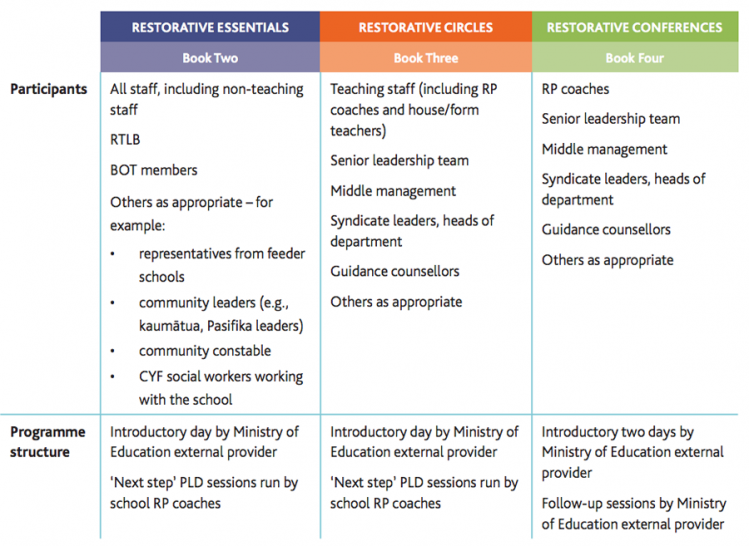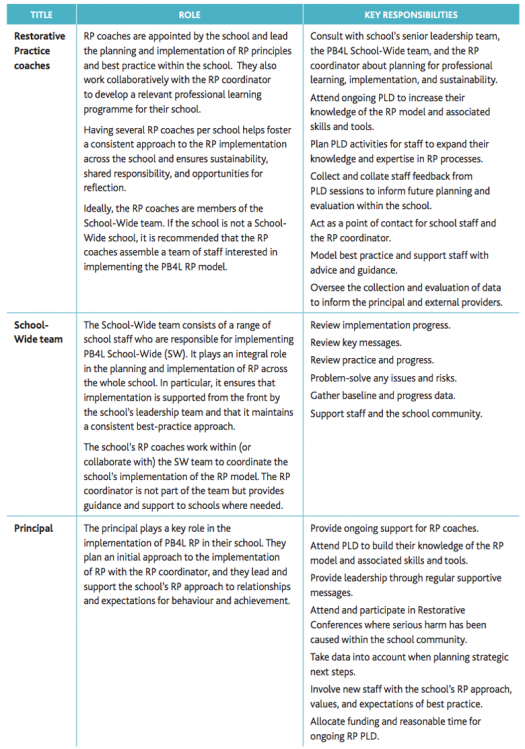Design elements
Target for support (strengths and needs)
Positive Behaviour for Learning (PB4L) Restorative Practice is a relational approach to building and maintaining positive, respectful relationships across the school community and offers staff best-practice tools and techniques to restore relationships when things go wrong. By building and maintaining positive, respectful relationships within a school, staff to staff, staff to student and student to student, issues are more easily managed.
PB4L Restorative Practice encourages and supports schools to analyse their existing values and practice and evaluate how effective their current strategies are for building and maintaining relationships and resolving differences and conflict. It is based on a set of best practice tools and techniques to support a consistent and sustainable approach to managing positive, respectful relationships within the school.
Expected outcomes
Evidence from pilot school practice suggests that by implementing the PB4L Restorative Practice model, schools can expect:
- a calmer school environment, with less classroom disruption and more time for teaching
- an increase in the engagement and learning of students in the classroom
- growth in relational and problem-solving skills, both for adults and students across the school community
- improvements in attitudes and relationships across the whole school community
- a consistent best-practice approach across the whole school community that aligns with the school’s shared values.
What data is used to support access decision?
The availability of PB4L Restorative Practice to schools will be determined by key consideration factors including (but not limited to) those outlined below:
- High numbers of Ministry priority learner groups: Māori, Pasifika, special education needs, and low socio economic areas.
- School Senior Leadership Team commitment and support from Board of Trustees to implement PB4L Restorative Practice.
- School has the capacity and the ability (to commit sufficient time and staff) to implement PB4L Restorative Practice over the next 3–5 years, as well as maintain other initiatives in which they are engaged.
- Preferably a PB4L School-wide registered and participating school.
Delivery design (who, how long, interactions)
PB4L Restorative Practice is currently being piloted in 21 secondary schools. Once the model has been tested, refined and evaluated, it will be made available to up to 200 schools by 2017, commencing July 2015.
The PB4L Restorative Practice model has three key interrelated components:
- Restorative Essentials
- Restorative Circles
- Restorative Conferences
PB4L Restorative Practice model
The first and most fundamental component is Restorative Essentials, which is built on and further developed in the use of Restorative Circles and Restorative Conferences.
In the first stage, external providers deliver PLD to all school staff, including non-teaching staff, on the Restorative Essentials. Following this, the Restorative Practice coordinator supports the coaches to plan and run relevant, dynamic, and regular Essentials PLD for their school, using the planning templates and modules in Book Two.
PLD in Restorative Circles is structured like Essentials PLD: an introductory session by an external provider followed by in-school sessions by the Restorative Practice coaches. Because Restorative Conferences are more intensive and specialised, PLD in them is fully covered by Ministry-endorsed external providers. Schools that are interested in developing their skills in Restorative Conferencing as a next step after Restorative Essentials may choose to do so before undertaking the Restorative Circles PLD.
Overview of Restorative Practice professional learning and development
How will the support contribute to classroom practice and school capability?
A range of support is available for schools to support the implementation of PB4L Restorative Practice:
- Ongoing practice support for Restorative Practice coaches, appointed by and based in their schools
- External PLD (professional learning and development)
- Digital and hard copy best-practice resources and materials
How will the support contribute to building educationally powerful relationships with parents, whānau/family, hapu, iwi, and community?
There are many opportunities for a school to connect with the wider school community about PB4L Restorative Practice. For example:
- New enrolments offer an opportunity for introducing PB4L Restorative Practice concepts and policies. School staff responsible or introducing new students and their whānau to the school community can explain to them the school’s Restorative Practice approach to relationships, behaviour, and achievement expectations.
- Student cohorts transitioning from year 8 to year 9 can be introduced to the PB4L Restorative Practice model through school assemblies and form class (home room) activities.
- The school’s board of trustees, the local community constable, health providers, RTLBs, and social workers could be invited to attend a Restorative Essentials whole-staff PLD day.
- With the support of the school’s senior leadership team, whānau leaders and leaders of ethnic groups within the school community could introduce Restorative Essentials to the wider community and provide opportunities for others to develop restorative skills.
Fidelity elements (small groups, one on one, timing)
Once PB4L Restorative Practice is established in a school, ongoing PLD sessions on Restorative Essentials should continue while Restorative Circles and Restorative Conferences are being introduced. This is particularly important for new teachers coming into the school, especially provisionally registered teachers.
How is support monitored and measured in terms of outcomes?
During the implementation of PB4L Restorative Practice an evaluation will be carried out by an independent evaluator. This evaluation will determine how well PB4L Restorative Practice is being implemented and the impact on restorative environments within schools.
The evaluation will run concurrently as the implementation of PB4L Restorative Practice progresses. Monitoring and evaluation activities will assess the best-practice delivery and implementation, as well as assessing performance against the expected outcomes.
What needs to be sustained?
Long-term sustainability of PB4L Restorative Practice requires:
- ongoing internal PLD to help embed relational and restorative approaches
- best practice approaches to build positive and respectful relationships and school communities
- working collaboratively and inclusively.
Roles and responsibilities for support
What are the conditions for successful delivery?
The table below outlines the key roles and responsibilities PB4L Restorative Practice for school staff. It is followed by a description of the important roles that the Restorative Practice coaches and students play in Restorative Practice.
Roles and responsibilities within PB4L Restorative Practice for school staff
Return to top



